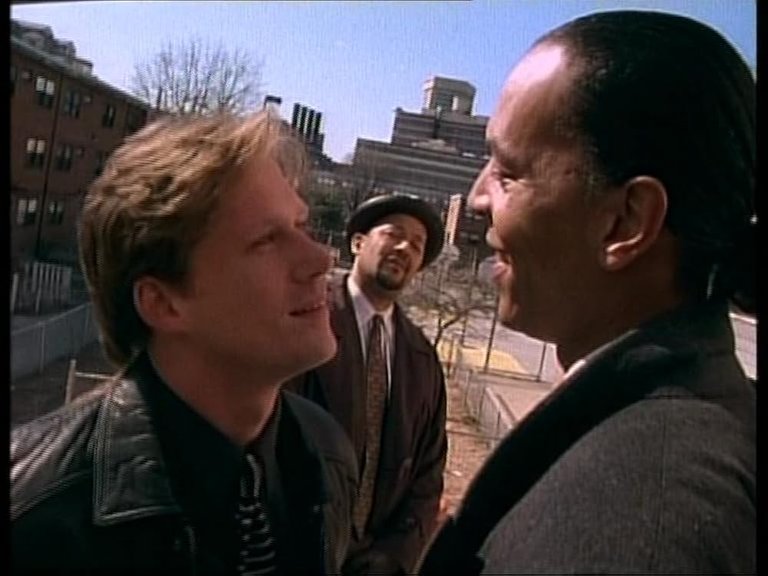Television Review: Damage Done (Homicide: Life on the Street, S4X20, 1996)

Damage Done (S04E20)
Airdate: 3 May 1996
Written by: Jorge Zamacona
Directed by: Jace Alexander
Running Time: 47 minutes
Season 4 of Homicide: Life on the Street remains a paradoxical turning point for the series, delivering some of its most compelling episodes while simultaneously signalling the beginning of a tonal and structural shift towards a more conventional, Hollywood-influenced narrative style. Among these, Damage Done—the inaugural chapter of the Luther Mahoney Saga—stands out as both a triumph of character-driven tension and a harbinger of the show’s gradual drift away from its gritty, documentary-like realism. While the episode deftly introduces one of the series’ most iconic villains and deepens the moral complexity of its protagonists, it also exemplifies the creative compromises that would come to define Homicide’s later seasons, trading procedural authenticity for heightened melodrama.
The episode centres on a brutal drug war between two Baltimore kingpins: the volatile, street-smart “Drak” Fortunato (Kevin Thigpen) and the calculating, intellectually superior Luther Mahoney (Erik Dellums). After six individuals—including a family—are killed in a short time, Detective James Kellerman (Reed Diamond) is drawn into the case upon discovering an eight-year-old girl who survived her family’s massacre by hiding in a closet. This discovery becomes the emotional linchpin of the episode, as Kellerman’s growing bond with girl’s cousin, schoolteacher Amy Jennings (Ingrid Rogers), blurs the line between professional duty and personal investment. Their tentative romance, marked by mutual vulnerability, adds a layer of human fragility to Kellerman’s otherwise stoic demeanour, foreshadowing the moral ambiguities that would define his arc in subsequent seasons.
Kellerman’s investigation, aided by Detective Lewis (Clark Johnson) and the Vice Unit, exposes the stark contrast between Drak and Mahoney. Drak, a high school graduate with a nihilistic worldview, openly defends his criminal empire as a natural response to systemic disenfranchisement. Thigpen imbues the character with a raw, unpredictable energy, making him both repellent and oddly sympathetic. Mahoney, however, emerges as the more insidious threat: a college-educated philanthropist who uses community projects as a smokescreen for his ruthlessness. Dellums’ understated performance—all icy composure and veiled threats—elevates Mahoney into one of 1990s television’s most memorable villains, a precursor to the sophisticated antiheroes of prestige dramas like The Wire.
The detectives’ inability to legally implicate either kingpin underscores Homicide’s recurring theme of institutional impotence. Despite their suspicions, Mahoney’s charitable façade and Drak’s streetwise evasion leave the unit grasping at shadows. This futility peaks in a taut confrontation where Kellerman’s gun jams during an arrest attempt, leaving him at Drak’s mercy. In a subversion of expectations, Drak spares Kellerman, not out of compassion but to mock the detective’s reliance on a flawed system. The scene is a masterclass in tension, exposing Kellerman’s vulnerability while reinforcing Drak’s nihilistic worldview.
The episode’s resolution, however, strains credulity. A drug addict’s sudden confession—implied to be orchestrated by Mahoney—allows the case to close with unsatisfying neatness. This contrivance, while serviceable for advancing the Mahoney arc, undermines the series’ trademark commitment to procedural realism. The subsequent “peace vigil,” where Drak is assassinated in front of dozens of witnesses, delivers a characteristically bleak twist: Mahoney’s feigned surprise as he surveys his rival’s corpse is a chilling reminder of his omnipotence. Yet the abruptness of Drak’s demise feels less like a narrative necessity than a rushed effort to escalate stakes for future episodes, sacrificing emotional payoff for serialised momentum.
Writer Jorge Zamacona’s script excels in deepening Kellerman’s complexity. His relationship with Amy Jennings—a rare foray into romance for the series—reveals a softer, more introspective side, contrasting with his professional ruthlessness. Diamond’s performance subtly conveys Kellerman’s internal conflict, particularly in his decision to release Drak—a moment that hints at a personal code of honour, however flawed. This arc lays groundwork for his later descent into moral ambiguity, making Damage Done a pivotal chapter in his journey.
That said, the episode avoids reducing its ensemble to mere satellites around Kellerman. Clark Johnson’s Lewis, for instance, shines in a subplot where his shared history with Drak—they attended the same high school—adds ironic texture to their interactions. Similarly, Thigpen’s portrayal of Drak balances menace with pathos, ensuring the character’s death resonates as both inevitable and tragic.
The episode’s nihilistic climax—where Mahoney’s triumph is underscored by the detectives’ powerlessness—aligns with Homicide’s signature bleakness. Yet it also exemplifies the risks of personalising the unit’s conflicts. By tying Kellerman’s emotional stakes so directly to the case, the episode edges toward melodrama, a tone at odds with the series’ earlier, more detached storytelling. This shift, while effective in isolation, set a precedent for the increasingly soap-opera-like arcs of later seasons, where character-driven subplots often overshadowed the procedural rigour that once defined the show.
Damage Done remains a fascinating study in contrasts. Zamacona’s script successfully plants seeds for the Mahoney Saga, a storyline that would yield some of the series’ most gripping moments. Dellums’ magnetic performance ensures Mahoney’s menace lingers long after the credits roll, while Diamond’s nuanced portrayal of Kellerman adds depth to a character previously defined by cocky bravado.
However, the episode’s reliance on contrived resolutions and heightened emotional stakes signals a departure from the series’ roots. The detectives’ work, once portrayed as a gruelling slog through bureaucracy and dead ends, begins to feel increasingly dictated by personal vendettas and operatic twists. While this evolution broadened Homicide’s appeal, it diluted the unflinching realism that made it a critical darling.
RATING: 7/10 (+++)
Blog in Croatian https://draxblog.com
Blog in English https://draxreview.wordpress.com/
InLeo blog https://inleo.io/@drax.leo
Hiveonboard: https://hiveonboard.com?ref=drax
Rising Star game: https://www.risingstargame.com?referrer=drax
1Inch: https://1inch.exchange/#/r/0x83823d8CCB74F828148258BB4457642124b1328e
BTC donations: 1EWxiMiP6iiG9rger3NuUSd6HByaxQWafG
ETH donations: 0xB305F144323b99e6f8b1d66f5D7DE78B498C32A7
BCH donations: qpvxw0jax79lhmvlgcldkzpqanf03r9cjv8y6gtmk9